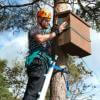Camera traps have been a key part of the conservation toolkit for decades. Remotely triggered video or still cameras allow researchers and managers to monitor cryptic species, survey populations, and support enforcement responses by documenting illegal activities. Increasingly, machine learning is being implemented to automate the processing of data generated by camera traps.
A recent study published showed that, despite being well-established and widely used tools in conservation, progress in the development of camera traps has plateaued since the emergence of the modern model in the mid-2000s, leaving users struggling with many of the same issues they faced a decade ago. That manufacturer ratings have not improved over time, despite technological advancements, demonstrates the need for a new generation of innovative conservation camera traps. Join this group and explore existing efforts, established needs, and what next-generation camera traps might look like - including the integration of AI for data processing through initiatives like Wildlife Insights and Wild Me.
Group Highlights:
Our past Tech Tutors seasons featured multiple episodes for experienced and new camera trappers. How Do I Repair My Camera Traps? featured WILDLABS members Laure Joanny, Alistair Stewart, and Rob Appleby and featured many troubleshooting and DIY resources for common issues.
For camera trap users looking to incorporate machine learning into the data analysis process, Sara Beery's How do I get started using machine learning for my camera traps? is an incredible resource discussing the user-friendly tool MegaDetector.
And for those who are new to camera trapping, Marcella Kelly's How do I choose the right camera trap(s) based on interests, goals, and species? will help you make important decisions based on factors like species, environment, power, durability, and more.
Finally, for an in-depth conversation on camera trap hardware and software, check out the Camera Traps Virtual Meetup featuring Sara Beery, Roland Kays, and Sam Seccombe.
And while you're here, be sure to stop by the camera trap community's collaborative troubleshooting data bank, where we're compiling common problems with the goal of creating a consistent place to exchange tips and tricks!
Header photo: Stephanie O'Donnell
No showcases have been added to this group yet.
- @avilabon
- | He/Him/His
My name is Albert Vila, and I have a multidisciplinary background in earth sciences, design, and technology. I hold degrees in Environmental Sciences, GIS, Bioarchitecture, and Emerging Futures Design. My work focuses on biodiversity, natural areas, and technology.
- 0 Resources
- 0 Discussions
- 5 Groups
Noé
Hi! I am Aurélie, a dedicated French ornithologist and engineer specialized in conservation technologies. I am currently Program manager for the biodiversity of natural habitats' program in a French NGO called Noé.

- 0 Resources
- 1 Discussions
- 5 Groups
- @Lindakim
- | She
I am a GIS analyst in the field of conservation
- 0 Resources
- 1 Discussions
- 9 Groups
- 0 Resources
- 0 Discussions
- 1 Groups
Gui
- 0 Resources
- 0 Discussions
- 7 Groups
Ol Pejeta Conservancy
Endeavoring to implement tech solutions for conservation.



- 0 Resources
- 18 Discussions
- 11 Groups
- @ppebs
- | she/her
Primatologist who studies human-primate coexistence and self-medicative behavior in non-human primates
- 0 Resources
- 1 Discussions
- 7 Groups
- @julianowack
- | she/her
Ecophysiologist interested in species conservation and how species cope and adapt to environmental changes, including climate change and urbanisation.
- 0 Resources
- 0 Discussions
- 3 Groups
Liverpool John Moores University
Sensors, remote sensing, embedded systems, Drones
- 0 Resources
- 1 Discussions
- 7 Groups
Wildlife Drones
Wildlife Drones has developed the world’s most innovative radio animal-tracking system using drones so you can track your radio-tagged animals like never before.


- 18 Resources
- 8 Discussions
- 31 Groups
KORA
- 0 Resources
- 0 Discussions
- 2 Groups
- 0 Resources
- 0 Discussions
- 9 Groups
Our new paper uses data from the citizen science project, Seabird Watch (hosted on the Zooniverse platform; seabirdwatch.org), to measure seabird phenology. Volunteers marked birds in time-lapse images to investigate...
13 March 2024
EcoAssist has now incorporated the Deepfaune v1.1 species identification model for camera trap images, capable of recognizing 26 European species. The model is developed by Deepfaune initiative. More information is...
12 March 2024
Catch up on the conservation tech discussions and events that happened during World Wildlife Day 2024!
7 March 2024
EcoAssist introduces a free African species identification model for camera trap images, capable of recognising 30 species.
5 March 2024
The primary focus of the research is to explore how red deer movements, space use, habitat selection and foraging behaviour change during the wolf recolonization process.
10 February 2024
Camera traps often monitor larger animals, so passive infrared sensor tends to miss small and fast species like mustelids. Researchers tested the Mostela against a tree-mounted camera trap to compare performance and...
8 February 2024
Article
An update on @Alasdair and @adanger24's HWC project
11 January 2024
Hi! CAMPHIBIAN project develops an underwater camera trap for amphibian. The interest has been proven on newts and grass snake in NW Europe. We are looking for early users worldwide, diversify target species and...
13 December 2023
Outstanding chance for a motivated and ambitious individual to enhance their current project support skills by engaging with a diverse array of exciting projects in the field of biodiversity science.
11 December 2023
Article
Read our interview with Clementine Uwamahoro, African Parks’ Country Manager in Conservation Technology overlooking technology operations for both Akagera National Park and Nyungwe National Park.
29 November 2023
TagRanger® is a state-of-the-art wildlife finding, monitoring and tracking solution for research, conservation and environmental professionals. With superior configurability for logging data, reporting location and...
23 November 2023
Passionate wildlife researcher and tech user, making strides in Grumeti, the heart of western Serengeti,Tanzania, using Camera Traps to gain priceless insights into the lives of this unique fauna and contributing...
21 November 2023
August 2025
event
event
September 2025
event
event
event
October 2023
event
event
58 Products
Recently updated products
4 Products
Recently updated products
| Description | Activity | Replies | Groups | Updated |
|---|---|---|---|---|
| I think the big thing is power consumption. Commercial camera traps have a large power (current) dynamic range. That means they can often swing from ~0.1 mA to ~1000 mA of current... |
|
Camera Traps | 8 months 3 weeks ago | |
| As others have said, pretty much all image models at least start with general-subject datasets ("car," "bird," "person", etc.) and have to be refined to work with more precision... |
+20
|
AI for Conservation, Camera Traps | 8 months 4 weeks ago | |
| This is a thread for anyone who has questions about AI for Conservation Office Hours 2025.We're once again teaming up with Dan Morris from... |
|
Acoustics, AI for Conservation, Camera Traps, Community Base, Geospatial | 8 months 4 weeks ago | |
| Hi Eugene!Interesting project!I already signed up to test it!Cheers,Lars |
|
AI for Conservation, Camera Traps | 9 months 1 week ago | |
| Thanks :)We are working on making it smaller and simpler using the latest openMV board. |
+15
|
Camera Traps | 9 months 1 week ago | |
| Hi everyoneMy first post on this site - not sure if this is the proper group.I've placed a few trail cams in Florida. After 3 months and... |
|
Camera Traps | 9 months 1 week ago | |
| Hi Lucy,I now realised it is an old thread and you most likely have already found a solution long ago but this might be of interest to others.As mentioned previously, it is... |
+5
|
Camera Traps, Data management and processing tools, Open Source Solutions, Software Development | 9 months 1 week ago | |
| Yes baboons. But this area has a few different primate species. In the weekend three species were present.Yes, the thermal ones will be spectacular. I wondering what other species... |
|
Camera Traps | 9 months 3 weeks ago | |
| Hi Brett, I am interested in developing really low cost multi channel underwater acoustic recorders. Can you tell me a bit more about the board and stuff you were using... |
|
Build Your Own Data Logger Community, Acoustics, Camera Traps, Climate Change, East Africa Community, Marine Conservation, Open Source Solutions, Protected Area Management Tools | 9 months 3 weeks ago | |
| For the record now that this is here:This error typically occurs when the wrong number of classes is given to timm.create_model. You should try to specify num_classes=30... |
|
Camera Traps, AI for Conservation | 9 months 4 weeks ago | |
| Product added to the Inventory : Tikee |
|
Camera Traps | 10 months ago | |
| Do you use camera traps? If so, we'd love if you could take five minutes to fill out this survey: tinyurl.com/zambasurveyWith our WILDLABS... |
|
AI for Conservation, Camera Traps, Data management and processing tools, Software Development, Open Source Solutions | 10 months 1 week ago |
From Autonomous Cars to Aqualink: Developing a Reef Monitoring System
9 June 2020 12:00am
Event: Arm’s AI Virtual Tech Sessions
 Arm
Arm
9 June 2020 12:00am
How do I get started using Machine Learning for my camera traps?
9 June 2020 12:00am
Repairing Camera Traps
28 November 2019 11:20am
14 December 2019 8:59pm
Hi Laure,
Firstly, a great article and a big part of the inspiration behind the idea to reuse, repair and 'upcycle' devices like camera traps. Thanks so much for the links also. The Google Sheet is a great idea and thanks for building it! I recently posted a Twitter poll to find out the most common cameras being used so we can make sure to cover their assessment. And the Restart Project looks amazing! I love it. I've fallen a bit behind with a couple of other things, but looking forward to getting back to the broken camera hacks soon.
Cheers,
Rob
8 June 2020 5:47pm
Hi everyone,
I am resurrecting this thread as WILDLABS is currently planning an online tutorial on camera trap repairs in the field on 23rd July at 11 AM ET on which I'll be co-presenting. Do join then if the topic is still of interest! Also, if you've got repair tips you'd be willing to share on this webinar, possibly as a short step by step video, please get in touch.
Diagnosing the cause of malfunctions is a recurring theme on this thread but are there other issues you would like to learn more about or malfunctions you encounter regularly? I created this spreadsheet a while back to get an idea of what the most common camera models and failures were. if you are interested and have a couple minutes, could you contribute to it? It would really help make the tutorial webinar as focused and relevant as possible and maybe create more tutorials and ressources at a later stage.
Announcing the 2020 CLP Team Award Winners
8 June 2020 12:00am
Innovator Interview: Hack the Poacher
4 June 2020 12:00am
Competition: 2020 Hackaday Prize
26 May 2020 12:00am
Free underwater camera units
10 January 2020 10:06pm
19 May 2020 11:23am
Is this offer still open
WILDLABS Tech Tutors: Season One
19 May 2020 12:00am
Era of the Condor: A Species' Future in Recovery
5 May 2020 12:00am
Competition: iWildCam 2020
4 May 2020 12:00am
Guidelines or Protocols for Camera Trapping Monitoring of Eurasian Otters?
20 April 2020 10:55am
28 April 2020 3:05pm
Hi Naomi,
I'm not aware of any guidelines published, but we've got the smooth coated otter in our camera traps before, and I suggest you follow a stratified sampling approach. You can stratify habitats along streams and flowing water bodies and place camera traps along stream banks especially where there are reed beds etc.
WILDLABS Community Call Recording: Rainforest X-PRIZE
30 March 2020 12:00am
Protocols for IDing big batches of camera trap data
5 March 2020 10:38am
19 March 2020 10:01am
Hi Morgan and Tim,
Thank you so much for these resources, I will go through these and get back to you with any questions.
Best,
Michelle
28 March 2020 6:22pm
Hi Michelle,
I had a group of undergrads help me with a 40,000-image dataset a few years back. We used the TEAM network Wild.ID program, so each photo that was tagged indicated who tagged it. That was helpful for checking quality later on. For our common, unmistakeable species (e.g. whitetail deer), I didn't require a second identification, but for more challenging groups (foxes, mustelids), I would often have a second person review the ID, or do it myself. Later on, I had a student go through all the tagged images of a particular species (gray squirrel, etc.) and verify the first ID. I found that some of the undergrads were very reliable in their ability to ID the species, whereas some other students needed to have their work checked more meticulously. I later thought of the idea of building a training set of say, 100 photos, to have each student run through to get a sense for their familiarity with the species, but also their ability to handle the more tricky scenarios that come up often in camtrap datasets.
Most folks could only handle 1-1.5 hours of continuous tagging. I had a few enthusiasts who would go for 2 hours straight, but that was rare. We logged effort in a shared google spreadsheet, where the students noted the dataset they worked on, any issues that came up, and any individual images that needed a second check.
I also tried to set up a more ergonomic workstation for folks (multiple monitors raised up, ergonomic mouse, etc.). Since the motion is so repetetive, easy for folks to develop carpal tunnel syndrome.
If you are dealing with a much larger dataset, you might want to look into more sophisticated AI/automation methods, but for a smaller project, this was doable. If you have a university connection, you can often recruit folks through chapter groups of The Wildlife Society. Student are often eager to gain experience, although many don't stick with it once they find out how unglamorous it is!
Good luck!
-Andy
29 March 2020 5:33am
Hi Tim,
Your diagramme shows a USB connection between the camera and the RPi. What kind of camera is it? Also, does this mean the RPi lives with the camera in the field?
Very interesting work.
Thanks,
-harold
Webinar: Citizen Science Online
 SciStarter
SciStarter
26 March 2020 12:00am
Enter the Zooniverse: Try Citizen Science for Yourself!
18 March 2020 12:00am
Testing an Early Warning System to Mitigate Human-Wildlife Conflict on the Bhutan-India Border
11 March 2020 12:00am
Announcing the iWildCam 2020 Camera Trap Kaggle Competition!
10 March 2020 7:08pm
3 Ways Your Conservation Technology Could Become a Shiny Pile of Junk, and How to Avoid It
9 March 2020 12:00am
Project Advice: Average speed camera system
7 March 2020 6:26pm
#Tech4Wildlife 2020 Photo Challenge In Review
4 March 2020 12:00am
Call for Nominations: Tusk Conservation Awards
3 March 2020 12:00am
Hawai'i Conservation Conference
 Hawaiʻi Conservation Alliance
Hawaiʻi Conservation Alliance
28 February 2020 12:00am
HWC Tech Challenge Update: Thermal Elephant Alert System
17 February 2020 12:00am
Average speed system needed
15 December 2019 9:27am
20 December 2019 1:11pm
Dear Sam,
PS. As a starter we could easily have rumble strips put in to slow traffic down at teh beginning and teh end so that the vehicles would not be flying past your detector.
I do understand this challenge as when collecting data over 700 metre stretches using a stopwatch we tried to catch numberplates with a standard motion camera and unless the vehicles were slow we never got the number plate.
20 December 2019 1:15pm
PPS 4 - 800 should have been 4-8000 THOUSAND
20 December 2019 1:16pm
Hi Gregory,
That is quite shocking to hear that a road could be so detrimental to wildlife. If you were able to place a speed hump or rumble strip where you place the camera you could even embed the metal detecting sensor in them to ensure accurate detection of every vehicle when they are going slower.
Our camera takes a burst of images and this can be set to be quite a quick burst or a slower burst so with a little bit of testing I am sure we could get the numberplates.
I am assuming that a lot of time these collisions happen at night. Would there be a way to have a fixed light at the camera locations as otherwise the cameras can be blinded by headlights and taillights making reading the VRN difficult.
At the moment our system is satellite connected. This does have a relatively high monthly data cost. We are also planning to develop a cellular version but this will require more funding and development time that we have not got yet.
The system is in the final stages of development and we plan to launch it in mid-2020 once it has undergone some prolonged field trials at ZSL sites, so it is not currently available. Final costings are still under review and will be released early next year.
I am sorry that we are not able to provide this capability to you right now.
Have you found any commercially available camera systems? In the UK I believe the automatic number plate recognition cameras placed on gantrys over motorways are called SPECS and a quick google said they are sold by a company called Jenoptik. If you find out how much they are and how they work, perhaps you could update this thread?
Thanks,
Sam
A New Cloud Platform Unveils the Most Diverse Camera Trap Database in the World
17 December 2019 12:00am
Camera trap ML competition
20 November 2019 12:32am
Advice Needed: Daytime IR Flash?
17 November 2019 7:06pm
Counting night time visitors on a budget
16 November 2019 4:40pm
Camera Trap Symposium - Go-Long Board
8 November 2019 12:10am



































































14 December 2019 8:50pm
Hi Rob, Dave and all,
So glad to see and join an active conversation on this. I am not directly using camera traps in my work but the lifetime of conservation technologies is something I have been thinking about and I am keen to get involved in finding solutions.
Could a Google spreadsheet like this one help identify those who are interested and the extent of the problem/most common issues ? If there is interest in participating, events on the Restart Project model Alasdair mentioned would be great places to get a sense of the most common faults and potentially create tutorials for those Level 1 repairs.